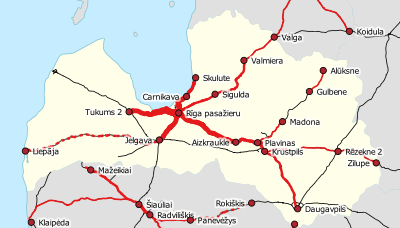Latvian Railways

Latvian Railways (Latvian: Latvijas dzelzceļš or LDz) is the main state-owned railway company in Latvia with more than 12,400 employees. It owns 1,933.8 kilometres (1,201.6 mi) of 1,520 mm (4 ft 11 27⁄32 in) Russian gauge railway lines and 33.4 kilometres (20.8 mi) of 750 mm (2 ft 5 1⁄2 in) narrow gauge railway lines in Latvia.[1]
It has 6 daughter companies:
- AS "LatRailNet"
- SIA "LDZ Apsardze" (security)
- LDz infrastruktūra (infrastructure)
- LDz Cargo (transportation)
- LDz Ritošā sastāva serviss
Domestic routes

Passenger services are operated by Pasažieru vilciens. The passenger lines with current service are:
- Torņakalns – Tukums II Railway1
- Riga – Jelgava Railway2
- Jelgava – Liepāja Railway only once a week
- Riga – Daugavpils Railway3 3 to 4 times a day
- Krustpils – Rēzekne – Zilupe (border of Russia)
- Two trains a day from Riga continue past Krustpils on this diesel train line in Latvia's central and eastern countryside, as well as the daily service from Riga to Moscow.
- Rīga – Sigulda – Cēsis – Valmiera – Valga (border of Estonia)4
- Leaving the Riga central station, this branch includes neighborhood stations Zemitāni, Čiekurkalns, and Jugla. During Soviet times, electric trains went up to Sigulda but the service is now diesel. Sigulda has around 11 trains a day, Cēsis 6, Valmiera 4, and 3 trains a day continue the full length of the line to serve the Latvian / Estonian border towns of Valka and Valga through a joint station in Valga.
- Zemitāni – Skulte Railway5
- Pļaviņas – Gulbene
- This branch line from Pļaviņas (between Aizkraukle and Krustpils on the Riga – Daugavpils line) is served by two diesel trains a week from Riga. The trains arrive from Riga late on Friday and Sunday nights, leaving to return to Riga at 4am on Saturday and Monday mornings. An additional Saturday daytime service was suspended in 2012.
Lines where passenger services have been suspended in recent years include:
- Rīga - Reņģe (Border of Lithuania)
- Rīga – Ērgļi
- Jelgava – Meitene (Border of Lithuania)
- Jelgava – Krustpils
- Kārsava (Border of Russia) – Rēzekne – Daugavpils – Zemgale (Border of Lithuania)
- Eglaine (Border of Lithuania)- Daugavpils – Indra (Border of Belarus)
1 Electrified to Tukums 2 Electrified to Jelgava 3 Electrified to Aizkraukle 4 Electrified to Jugla, no electric trains go on the line. 5 Whole line is electrified
International routes
International overnight services to/from Riga are operated by Latvijas Ekspresis (Latvia Express). There are rail links with Russia, Lithuania, Belarus, and Estonia.
- Riga – Zilupe – Moscow
- Daily overnight service
- Riga – Zilupe – Saint Petersburg
- Daily overnight service
- Riga – Daugavpils – Minsk
- Every second day overnight service
- Daugavpils – Vilnius
- Two times a day every Saturday and Sunday
Freight services
Latvian railways carry a large quantity of freight cargo, and freight trains operate over the whole current passenger network, and a number of lines currently closed to passenger services.
.svg.png)
Other services
There is a narrow gauge railway between Gulbene and Aluksne, operated by the Industrial Heritage Trust, using Russian and Polish built heritage rolling stock. Three narrow gauge trains a day operate on the 33 km route between the two towns. Until 2012 a regular Saturday service train operated from Riga to Gulbene in the morning, returning in the late afternoon, and offered guaranteed connections with the narrow gauge trains; the service has been suspended on the grounds of insufficient passenger numbers.
Rolling stock
Diesel locos
Freight
- M62 – 33 locos
- 2M62 – 40 locos
- 2M62U – 30 locos
- 2TE10M – 10 locos
- 2TE10U – 14 locos
Passenger
- TEP70 – 15 locos
Shunt
- ČME3 (ChME3)- 57 locos
- TEM2 – 7 locos
- TGK2 – 1 loco
- TGM3 – 1 loco
- TGM23 – 2 locos
EMUs
- ER2 – 32 trains
- ER2T – 6 trains (7113-7118)
- ER2M – 1 train (No 605)
DMUs
- DR1A – 31 train
- DR1AM – 10 trains
- AR2 (railbus) – 1 train (used by workers on Jelgava-Krustpils line)
See also
References
- ↑ "Network Statement 2007" (PDF). Latvijas dzelzceļš. 15 June 2006. Archived from the original (PDF) on 23 February 2012. Retrieved 24 March 2015.